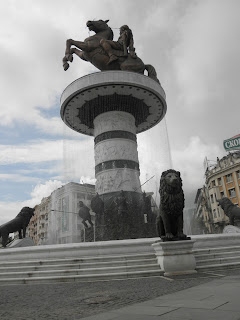"Skopje in winter is enveloped by an all-pervasive fog, symbolic of the conspiratorial overtones of a small Balkan city haunted by foreign diplomats and partisan intrigue."
LOL
We got here on a 6-hour bus from Skopje - 6 hours not because it's far as the crow flies but instead because the straight stretches of the two-lane road are short and are punctuated by steep ascents and descents on Balkan mountains. Slow semis creep up the mountains at perhaps 40 km/hour and we often waited behind them through blind turn after blind turn waiting for a chance to pass.
The Bulgarian and Macedonian countrysides seemed like a veritable temperate paradise - small village houses had gardens with hundreds of square feet of trellises with grapes which should be coming into season soon and, beyond them, fruit orchards and fields of tomatoes, peppers, eggplants, wheat, and corn.
Here in Skopje, we're staying with a friend of mine from college, Eric. He is a linguist who is doing his dissertation research right now on some shared features of Macedonian and Albanian (spoken by a large Albanian minority in Macedonia, including Skopje).
Skopje at 500,000 residents is much smaller than our previous stops, Istanbul (14 million) and Sofia (1.2 million). This has some pleasant side effects. The city is cheaper ($.60 for a cup of Turkish coffee vs. $2-3 in Istanbul; $.40 for 1.5 L of water vs. $1.5-3 in Istanbul) and much more walkable - from Eric's apartment in a nice residential part of town, it took us a full 15 leisurely minutes to walk downtown. What did we find?
Having been part of various other states (the Ottoman Empire until 1912, the Kingdom of Serbia which later became Yugoslavia), Macedonia only became an independent country in 1991 when it peacefully seceded from Yugoslavia.
You could easily imagine that a new young country might be interested in developing its own narrative of itself in all the usual areas - architecture, literature, music, art, etc, but that is not the whole story in Macedonia. In fact, Macedonia is locked in a bitter dispute with the Greeks over its very name.
Macedonia as a name for the region is very old, dating back at least to classical Greek times, and Alexander the Great was known to have been from these parts. The peoples of the region had different identities and spoke different languages back then, but the name has stuck, and is used both for a province of Greece and for the country. Greece is angry because they believe that the use of the name Macedonia contains an implicit claim over the Greek province, which Macedonia doesn't even make.
In what our host terms "a giant middle finger to Greece", Macedonia continues to fight the losing battle over using its name internationally and is in the process of stuffing Skopje's downtown with pretty ostentatious statuary. This one is officially called Warrior on a Horse ...
... but everyone knows it's supposed to be Alexander the Great. The scale might be hard to see here but the statue is 22m tall - 10x life-size! It also plays classical music in the afternoon and evenings, coordinated with changes in the fountain. It looks even more classical when you check out the spearmen at the base:
The small territory of Macedonia has had another famous son, Justinian I (who built the Hagia Sophia / Aya Sofya from Istanbul):
To reach the old city across the river, we crossed the incredible Kamen Most, built in the 15th century by the Ottomans on Roman foundations, touched up a few times over the years.
We toured pretty much all of the old city, including the Ottoman Fortress, the serene and understated Mustafa Pasha Mosque, the fruit and vegetable bazaar, and a lovely antique shop.
The highlight was the 17th c. Sveti Spas Church. The signs were eager to point out that as a legacy of Ottoman strictures, Christians had to keep their architecture restrained, and the building is in fact sunk 2 m into the ground. We expected something much grander and walked around three sides of it before realizing it was the church we were looking for.
The church has a 19th c carved wood iconostasis which was just incredible.
A detail of the intricate carving that it had on every part:
Lastly a shoutout to everybody back in the US and especially Michael: miss you guys and hope you're having a great summer!








And as you can tell from the pictures, we had "lost" our camera in a pocket of one of my bags - it was with us the whole time.
ReplyDelete"Skopje in winter is enveloped by an all-pervasive fog, symbolic of the conspiratorial overtones of a small Balkan city haunted by foreign diplomats and partisan intrigue. Your characters are spread all over the bar. A man in a trenchcoat silently creeps in and takes a seat in the back. He has a briefcase handcuffed to his arms. What do you do?"
ReplyDeleteThe GM waits patiently for your response.
Get some more Cheetos?
ReplyDeleteGlad to hear you found you camera! As far as cheetos....not so sure.
ReplyDelete